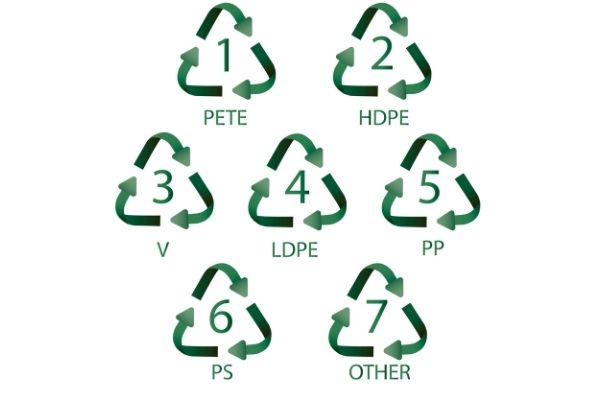One of the most important steps in recycling plastic is identifying what type of plastic you have. You can learn how to recognize plastics around your home by using the plastic by numbers or resin identification codes.
Below we provide an overview of the plastic identification codes and how they help you understand plastic recycling. We also provide you with a summary of each of the different types of plastic, from plastic number 1 to plastic number 7.
Quick Navigation
What is the Plastic Resin Identification Code?
In the late 1980s, the US Society of Plastics Industry (SPI) created a numbering system for plastics. This system’s purpose was to create consistency in plastic manufacturing and help the manufacturers and recyclers identify the different plastic types.
So how do the plastic codes work? There are 7 groups of plastics. Numbers 1 through to 6 represent the 6 most common types of plastic at the time. The final group, Number 7, was basically a catch-all for the remaining types of plastics that existed.
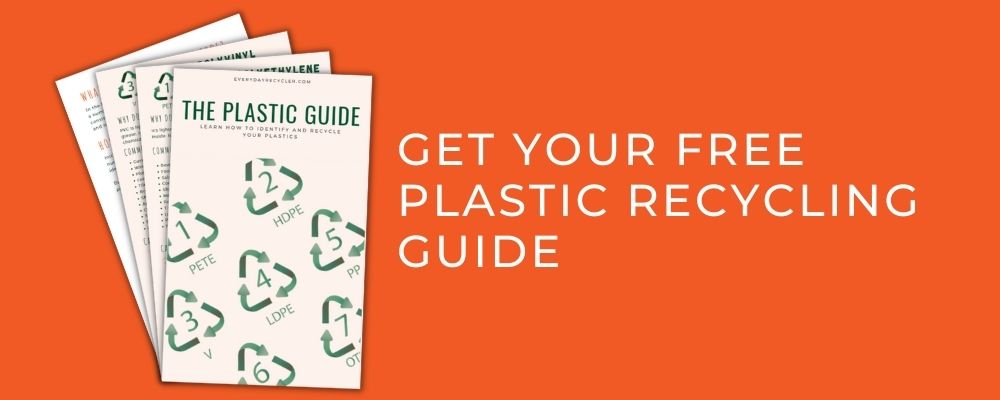
Plastic by Numbers for Recycling
Though originally developed for industrial use, the plastic identification numbers have become a useful tool as recycling efforts have expanded over the years. It’s become an easy way for consumers to identify the type of plastic an object is made from.
But the coding system isn’t perfect. The main problem is the plastic identification symbols with the chasing arrow around the number have become synonymous with recycling. Many people assume that any item with one of these symbols can be recycled, but that’s actually not the case for all numbers.
There are a few other issues with the resin identification code, including:
- The coding is voluntary for plastic manufacturers, so you don’t find it on every item.
- The codes do not distinguish between rigid and flexible plastics. Many plastics can be used in both rigid objects and flexible objects. Rigid items can generally go into your home-based recycling bin, while soft or flexible plastics need to be taken to a drop-off center.
- The resin codes only cover six common plastics. The seventh group now consists of many different types of plastics, including biodegradable, compostable, and mixed plastics. Because of this, it is often reported number 7 plastics can’t be recycled. However, the real answer depends on the type of plastic.
Given these issues, it might be time to revise the resin codes. This is up to the Society of Plastics Industry (SPI) and ASTM International, who controls them.
Fortunately, many countries are now moving towards a new labeling system for recycling. These new labels focus on the different types of materials in packaging and how each one should be handled. It puts the responsibility on the manufacturer to tell the consumer what should happen to the item at the end of its life.
If you want to learn more about these codes, check out How to Recycle: Recycling Symbols and Meanings.
But even with the issues with the codes and the possibility of new labeling being introduced, it’s still helpful for us to learn about the plastic resin codes. In many cases, it’s still the best way to work out if an item is recyclable or not.
So, here is the low down on the plastic by numbers 1 through 7.
The Short Version
Just because a piece of plastic has the chasing arrows with a number inside, this does n’t mean it’s recyclable. Here’s our handy guide:
#1 PLASTIC - PET
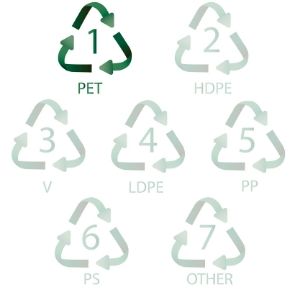
Polyethylene terephthalate (PET or PETE) is the most commonly produced plastic. It is plastic number #1 in the plastic resin code, illustrated by a number 1 in the chasing arrows. The most common item associated with PET would be the plastic water bottle. However, the majority of PET actually occurs in clothing, as polyester fibers.
PET is common for a good reason – it’s useful, lightweight, strong, provides a good protective barrier, doesn’t react with foods, it is safe and easy to recycle. Some common examples include beverage bottles, food bottles, shampoo containers, rope, carpet, and textiles like clothing.
General everyday PET items like bottles and jars are easily recycled in a curbside recycling program. Just make sure to clean the container and place them in your recycling bin. Other items like clothing or carpet cannot go into your curbside recycling, but there might be a specialist recycler around you who will take them.
PET is recycled into lots of items. Some examples are more clothing, carpets, pillow stuffing, boat sails, and auto parts.
Find out more on Polyethylene terephthalate or PET.

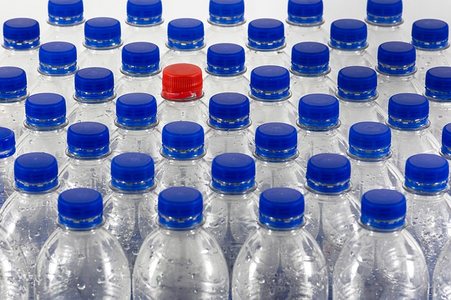
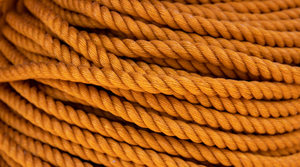

#2 PLASTIC - HDPE
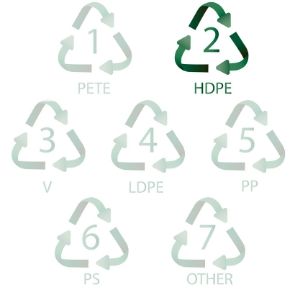
High-density Polyethylene or HDPE is a useful plastic, particularly for packaging. It’s stiff, durable, and strong, with good chemical resistance. You can identify it by the plastic number #2 symbol or a 2 inside the chasing arrows, usually on the bottom of the container.
HDPE comes in two forms: a rigid form and a soft, flexible form. Some everyday examples include juice bottles, shampoo bottles, household cleaner bottles, kid’s toys, and outdoor furniture. Examples of the soft form of HDPE include grocery and bread bags or cereal box liners. HDPE is also commonly used as insulation on wiring and cables.
High-density polyethylene is easy to recycle and can be used to make many different products. In its rigid form, simply clean out any excess food or liquid and place the container or bottle into your curbside recycling bin.
If you think it’s a soft plastic do the scrunch test. If it can be scrunched up and doesn’t bounce back to its shape, then it’s a soft plastic. Collect these and take them to your local drop off-center. See soft plastic recycling for more information.
Recycled HDPE is made into many different items including piping, outdoor furniture, buckets, bins, or garden edging and flowerpots.
Find out more on High-density Polyethylene or HDPE.


#3 PLASTIC - PVC
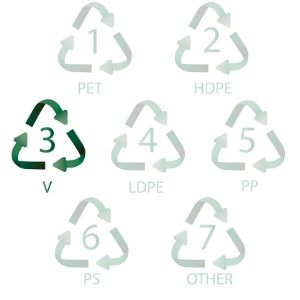
Polyvinyl chloride (PVC) is lightweight and strong. It has good resistance to chemicals and is cheap to make. But PVC is different from other plastics in that it has chlorine as its main ingredient.
Unfortunately, the addition of chlorine makes PVC hazardous to manufacture and difficult when it comes to disposal. When incinerated, it can release carcinogenic compounds.
There are many items around your home which might be made from PVC. These include vinyl flooring, window frames, gutters, plumbing pipes, or the outer shells of many appliances. Another common item that contains PVC is your credit card. Like HDPE, there are also flexible items made from PVC, including shower curtains, raincoats, cling film, and fire-retardant clothing.
Polyvinyl chloride can be recycled. However, it is unlikely you can access a program that recycles PVC, as they’re typically only open for commercial operations. But some places have recycling for vinyl flooring and PVC pipe – you might just need to look around.
Find out more on Polyvinyl chloride or PVC.
#4 PLASTIC - LDPE
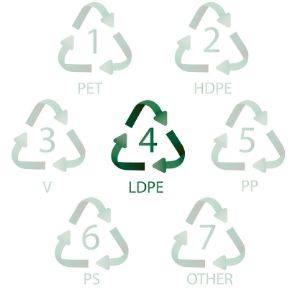
Low-density polyethylene (LDPE ) is a durable and flexible plastic with many different applications in our everyday lives. In plastic by numbers LDPE is easy to identify with the number #4 symbol, a 4 inside the chasing arrows. The good news is it’s also easy to recycle.
You’ll likely find many items in your everyday life made from LDPE. It is commonly used in food or general packaging, for squeezable bottles for condiments, container lids on drink bottles, or even in kid’s toys. It is also found in grocery bags, cling wrap, sandwich bags, lids, and frozen food bags as a flexible plastic. As with HDPE, LDPE is also commonly used as insulation on electrical wires and cables.
Recycling LDPE is similar to recycling HDPE. However, we recommend you check with your local authority as LDPE is not always accepted.
If it’s a rigid plastic and a regular container-type item like a bottle, it can be placed in your home recycling bin. If you have done the scrunch test and it is a soft plastic, collect them and take them to your local drop off-center. See our article on soft plastic recycling for more information.
Recycled LDPE is used in floor tiles, shipping envelopes or postal bags, outdoor furniture, and landscape timber or decking boards.
Find out more on Low-density Polyethylene or LDPE.
#5 PLASTIC - PP - Polypropylene
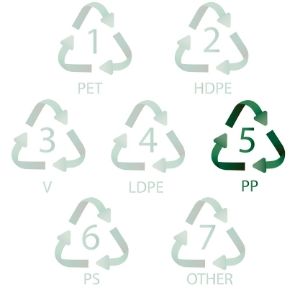
Plastic number 5 is Polypropylene (PP). It’s thermoplastic and can be identified by the number 5 in the chasing arrows symbol. PP has similar properties to PET, HDPE, and LDPE in being lightweight, but strong and providing good resistance to chemicals. The main difference is PP has a much higher melting point than the others. This makes it useful for hot materials like reusable food containers.
Common items made from PP are yogurt or margarine containers, syrup bottles, straws, Tupperware and other reusable food containers, disposable cups, and plates. It’s also used by the automotive industry and for lab equipment. Flexible types of Polypropylene include cereal box liners, plastic diapers, rope, banknotes, and it’s used in thermal underwear.
Check with your local authority to see if they accept Plastic no 5 as it is not always accepted. If your local area accepts it look for the number 5 in the chasing arrows. If it’s soft plastic, once you have done the scrunch test, collect it and take it to your local recycling drop-off center. See our piece soft plastic recycling for more information!
There are great recycled products made from plastic number 5 PP. Preserve has been using polypropylene to make new products since 1996, including bowls and containers.
Find out more on Polypropylene or PP.
#6 PLASTIC - PS - Polystyrene
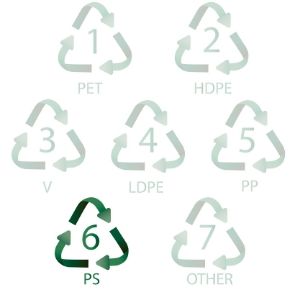
Polystyrene (PS), also commonly referred to as Styrofoam, is a versatile plastic. It’s most easily recognized as the white foam blocks protecting your new tv or mobile phone. Polystyrene is identified in the plastic by numbers as a 6 in the chasing arrows. Expanded polystyrene or EPS is the most common type of polystyrene. You will most likely recognize this because it looks like small bean bag balls stuck together.
Polystyrene is useful because it’s lightweight and rigid, meaning it can be cut, sanded, glued, or even painted. PS is used for packaging because it’s a good moisture barrier and has low thermal conductivity. It can also be made into rigid plastic objects where it is clear, hard, and brittle.
Other examples of polystyrene or Styrofoam are disposable coffee cups, takeaway clamshell containers, and beer coolers. It is also commonly used in building insulation.
Polystyrene can be recycled, but as with PVC and other more difficult plastics, it’s also a plastic that can’t be recycled at home. The only way to recycle Styrofoam is to find a specialist recycler. Read more on how to find them here.
Recycled polystyrene is often used to make foam packaging peanuts but can also be found in office objects like desk trays or rulers.
Why not learn more in our main article Polystyrene or PS.
#7 PLASTIC - Other
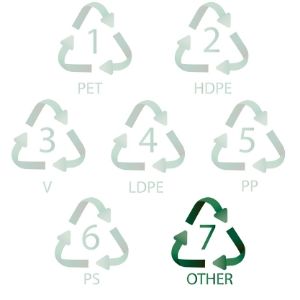
Plastic Number 7 can be viewed as the catch-all of plastics, for anything that doesn’t fall under numbers 1 to 6 (PET, HDPE, LDPE, PP, PS, and PVC). This includes a wide range of plastics with many different characteristics, with plastic ranging from recyclable, non-recyclable, mixed plastics, and biodegradable.
Some examples include polycarbonates, polylactic acid (PLA), acrylonitrile butadiene styrene (ABS), acrylic, melamine, and nylon – but remember, with so many types of plastics, this is far from a complete list. Some common items you might recognize include Lego blocks, computer keyboards, takeaway containers, eyewear, CDs, or plastic for 3D printing.
Unfortunately, most of the plastics which fall under the number 7 group can’t be recycled at home. Many of these cannot be recycled at all, but some can be processed at specialist recycling facilities – just make sure to do your research. We teach you how here.
We hope in the future, all these plastics will become more easily identified and more readily recycled. For now, we have to work harder to find the information.
Learn more about Plastic number 7
More Plastic by Numbers
We hope we’ve helped you better understand the plastic resin codes and how they support recycling in your everyday life. Stay tuned for more on how to recycle every day!
In the meantime, here are links on plastics and the plastic resin codes:


